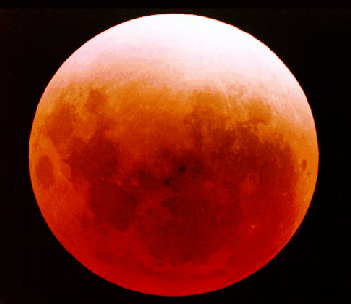Credit & Copyright: Andy Steere
Explanation:
Tonight's full moon would normally washout the spectacle of
Comet Hyakutake's lovely tail,
even for those far from light
polluted skies. Except that tonight comet observers are in luck - the
dance of the planets calls for a
total lunar eclipse!
Lunar eclipses are
caused when the Moon
passes through the Earth's shadow.
Although dimmed,
the eclipsed Moon may not appear completely dark.
Sunlight scattered into the
Earth's shadow after passing
around the planet's edge and
through its dusty atmosphere
can make the Moon take on dramatic shades of red during totality as
demonstrated in the above photo of the
November 1993 lunar eclipse.
Tonight,
totality begins at 6:26 p.m. EST and lasts
about an hour and a half. Weather permitting, the eclipse will be visible
for all those comet and moon watchers lucky enough to be on the
Earth's nightside.
Latest Comet Hyakutake images:
APOD Hyakutake Archive,
JPL,
Fayetteville
Observer-Times,
NASA's Night of
the Comet,
ICSTARS,
Jerry Lodriguss,
ScienceWeb,
Crni Vrh Obs.,
Cent. Mich. U.
1999 2000 2001 2002 2003 2004 2005 2006 2007 2008 2009 2010 2011 2012 2013 2014 2015 2016 2017 2018 2019 2020 2021 2022 2023 2024 2025 |
Yanvar' Fevral' Mart Aprel' Mai Iyun' Iyul' Avgust Sentyabr' Oktyabr' Noyabr' Dekabr' |
NASA Web Site Statements, Warnings, and Disclaimers
NASA Official: Jay Norris. Specific rights apply.
A service of: LHEA at NASA / GSFC
& Michigan Tech. U.
|
Publikacii s klyuchevymi slovami:
lunar eclipse - lunnoe zatmenie - kometa Hiyakutake - Refrakciya atmosfernaya
Publikacii so slovami: lunar eclipse - lunnoe zatmenie - kometa Hiyakutake - Refrakciya atmosfernaya | |
Sm. takzhe:
Vse publikacii na tu zhe temu >> | |
